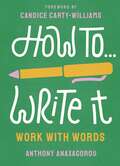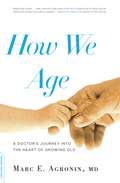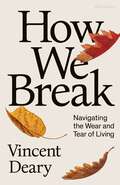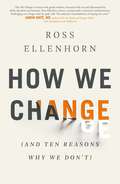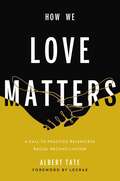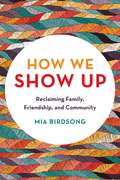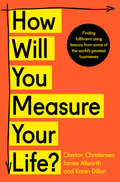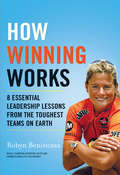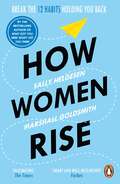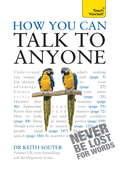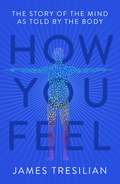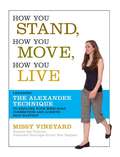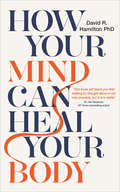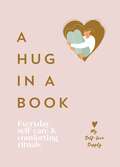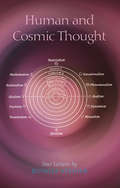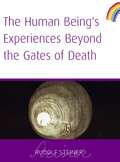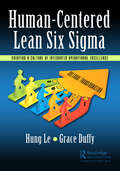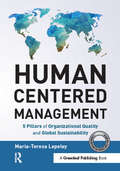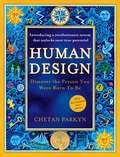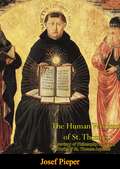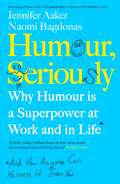- Table View
- List View
How To Write It: Work With Words (Merky How To #1)
by Anthony Anaxagorou_______________________________________________________How to Write It: Tell Your StoryThis book is a masterclass in the craft of writing and poetry from one of Britain's most celebrated poets and educators, T.S. Eliot Prize nominee Anthony Anaxagorou.Taking readers on a personal journey through his early life and school years, through to his relationship with literature, education poetry and writing, this book is filled with tips, anecdotes and publishing advice for anyone interested in getting their work seen. From Anthony's first slam win to the evolving British poetry scene, this book will provoke readers into thinking about their writing more carefully – be it a poem, short story or novel – and help them finally get their book out into the world.This book is essential reading for taking your work to the next level, and is introduced with an inspirational foreword by Sunday Times bestselling author, Candice Carty-Williams. _______________________________________________________ Designed to inspire and encourage readers to unlock their potential and provoke change, the How To series offers a new model in publishing, helping to break down knowledge barriers and uplift the next generation. Creatively presented and packed with clear, step-by-step, practical advice, this series is essential reading for anyone seeking guidance to thrive in the modern world. Curate your bookshelf with these collectable titles.
How We Age: A Doctor's Journey into the Heart of Growing Old
by Marc AgroninIn the tradition of Atul Gawande and Sherwin Nuland, Marc Agronin writes luminously and unforgettably of life as he sees it as a doctor. His beat is a nursing home in Miami that some would dismiss as "God's waiting room.” Nothing in the young doctor's medical training had quite prepared him for what he was to discover there. As Agronin first learned from ninety-eight-year-old Esther and, later, from countless others, the true scales of aging aren't one-sided-you can't list the problems without also tallying the hopes and promises. Drawing on moving personal experiences and in-depth interviews with pioneers in the field, Agronin conjures a spellbinding look at what aging means today-how our bodies and brains age, and the very way we understand aging.
How We Break: Navigating the Wear and Tear of Living
by Vincent Deary‘Exhilarating… Wise and compassionate’ New Statesman An expert, empathetic guide to the science, psychology and physiology of breaking, from the acclaimed author of How We AreWhat happens when our minds and bodies are pushed beyond their limits? Vincent Deary is a health psychologist who has spent years helping his patients cope with whatever life has thrown at them. In How We Break, he has written a book for all of us who sometimes feel we have reached our breaking point. Drawing on clinical case studies, cutting-edge scientific research, intimate personal stories and references from philosophy, literature and film, How We Break offers a consoling new vision of everyday human struggle. The big traumas in life, Deary points out, are relatively rare. More common is when too many things go wrong at once, or we are exposed to prolonged periods of difficulty or precarity. When the world shrinks to nothing but our daily coping, we become unhappy, worried, hopeless, exhausted. In other words, we break. Breaking, he shows us, happens when the same systems that enable us to navigate through life become dysregulated. But if we understand how the wear and tear of life affects us, then we have a better chance of navigating through times of burnout, stress, fatigue and despair. By equipping us with a better understanding of what happens to us when we're struggling to cope, and making a bold case for the power of rest and recuperation, How We Break helps chart a path through difficult times.
How We Change (and 10 Reasons Why We Don't): (and Ten Reasons Why We Don't)
by Dr Ross EllenhornA paradigm-shifting, instant classic in the making that challenges our assumptions about change by encouraging us to understand and embrace our resistance to it.We all have something we want to change about ourselves. But whether it's quitting smoking, losing weight, or breaking some common bad habit or negative behaviour pattern, we feel a sense of failure when we don't succeed. This often sets off a cascade of negative feelings and discouragement, making it even harder to change. The voice in our head tells us: Why bother?Successful change depends far more on understanding why we don't change, psychotherapist and sociologist Ross Ellenhorn insists. His decades-long career as a pioneer in helping people overcome extreme psychiatric experiences and problematic substance use issues - especially those whom the behavioural healthcare system has failed - especially those whom the mental healthcare system has failed - has lead him to develop an effective, long-term method to achieve transformation, from the simplest shifts to the most profound. In How We Change, Ellenhorn looks to the evolutionary imperatives driving us. We are wired to double down on the familiar because of what he calls the Fear of Hope - the act of protecting ourselves from further disappointment. He identifies the '10 Reasons Not to Change' to help us see why we behave the way we do, making it clear that there is nothing broken inside us - it's how we're built. By addressing this little known reality, he gives us hope and helps us work toward the change we seek. Ellenhorn speaks to the core of our insecurities and fears about ourselves, with a humour and kindness. By turning our judgements about self-destructive behaviours into curious questions about them, he teaches us to think about our actions to discover what we truly want - even if we're going about getting it in the wrong way. How We Change is a brilliant approach that will forever alter our perspective and help us achieve the transformation we truly seek.
How We Love Matters: A Call to Practice Relentless Racial Reconciliation
by Albert TateThis powerful book reimagines discipleship by begging us to acknowledge that racism exists in the Church—and offers the hopeful message that we can disciple it out. It is not an accident that racism is alive and well in the American church. Racism has, in fact, been taught within the church for so long most of us don&’t even recognize it anymore. Pastor Albert Tate guides all of us in acknowledging the racism that keeps us from loving each other the way God intends and encourages siblings in Christ to sit together in racial discomfort, examining the role we may play in someone&’s else&’s struggle. How We Love Matters is a series of nine moving letters that educate, enlighten, and reimagine discipleship in a way that flips the church on its head. In these letters that include Dear Whiteness, Dear America, and Dear Church, Tate calls out racism in the world, the church, within himself and us. These letters present an anti-racist mission and vision for believers to follow that helps us to speak up at the family table and call out this evil so it will not persist in future generations. Tate believes that the only way to make change is by telling the truth about where we are—relationally, internally, and spiritually. How We Love Matters is an exposition of relevant Biblical truth, a clarion call for all believers to examine how they see and understand each other, and it is a way forward toward justice, reconciliation, and healing. Because, yes, it is important that we love each other, but it is even more important how we love each other.
How We Show Up: Reclaiming Family, Friendship, and Community
by Mia BirdsongAn Invitation to Community and Models for ConnectionAfter almost every presentation activist and writer Mia Birdsong gives to executives, think tanks, and policy makers, one of those leaders quietly confesses how much they long for the profound community she describes. They have family, friends, and colleagues, yet they still feel like they're standing alone. They're "winning" at the American Dream, but they're lonely, disconnected, and unsatisfied.It seems counterintuitive that living the "good life"--the well-paying job, the nuclear family, the upward mobility--can make us feel isolated and unhappy. But in a divided America, where only a quarter of us know our neighbors and everyone is either a winner or a loser, we've forgotten the key element that helped us make progress in the first place: community. In this provocative, groundbreaking work, Mia Birdsong shows that what separates us isn't only the ever-present injustices built around race, class, gender, values, and beliefs, but also our denial of our interdependence and need for belonging. In response to the fear and discomfort we feel, we've built walls, and instead of leaning on each other, we find ourselves leaning on concrete.Through research, interviews, and stories of lived experience, How We Show Up returns us to our inherent connectedness where we find strength, safety, and support in vulnerability and generosity, in asking for help, and in being accountable. Showing up--literally and figuratively--points us toward the promise of our collective vitality and leads us to the liberated well-being we all want.
How Will You Measure Your Life?: With Award-winning Harvard Business Review Article How Will You Measure Your Life?
by Clayton Christensen James Allworth Karen DillonHow do you lead a fulfilling life? That profound question animates this book of inspiration and insight from world-class business strategist and bestselling author of The Innovator’s Dilemma, Clayton Christensen.
How Winning Works: 8 Essential Leadership Lessons From The Toughest Teams On Earth (Harlequin Non-fiction Ser.)
by Robyn BenincasaRobyn Benincasa has made an art form of extreme performance by competing and winning at the highest levels of sport and business.
How Women Rise: Break the 12 Habits Holding You Back
by Sally Helgesen Marshall Goldsmith_________________________________By the bestselling author of What Got You Here Won’t Get You ThereDo you hesitate about putting forward ideas? Are you reluctant to claim credit for your achievements? Do you find it difficult to get the support you need from your boss or the recognition you deserve from your colleagues?If your answer to any of these is ‘Yes’, How Women Rise will help get you back on track. Inspiring and practical by turns, it identifies 12 common habits that can prove an obstacle to future success and tells you how to overcome them. In the process, it points the way to a career that will satisfy your ambitions and help you make the difference you want to make in the world._________________________________‘Guidance on the habits you fall into that aren’t helping you achieve the success you deserve. It’s fascinating.’ Sunday Times‘How Women Rise is a great read.’ Lois P. Frankel, author of Nice Girls Don’t Get the Corner Office‘A great resource to discover the 12 habits that hold women back and how to overcome them.’ Forbes
How You Can Talk To Anyone: Teach Yourself (Teach Yourself)
by Dr Keith Souter""How You Can Talk To Anyone"" will change the life of any reader who finds themselves scared and shy in social situations - and it will have a pretty amazing effect on those who just need a bit of a confidence boost!
How You Feel: The Story of the Mind as Told by the Body
by James TresilianClose your eyes and ask yourself, 'what do I feel?'You might feel thirsty or tired. You might feel healthy and well or perhaps a little under the weather. Maybe you can feel that you are standing or that you are leaning over. You may also feel the world around you - the shape and texture of an apple in your hand, the feel of a chair you're sitting on.All these feelings have something in common, say psychologists and neuroscientists. They are all mental events, things that happen in the mind. But what if this is all wrong?What if it's not just the mind, but also the body itself that feels? And not merely physical sensations, but other feelings that seem to have nothing to do with bodies. Things like 'emotions' and 'intuitions' - joy or rage, anxiety or optimism, or the feeling of being hard done by or misunderstood?Drawing on the latest research and a range of classic and contemporary thought, How You Feel shows you that your brain and your body are two parts of a single system that creates your mind and mental life. You will discover that you don't have feelings, thoughts and emotions inside your body, you have them with your body. There can be no mind without the body.Psychology is no longer about the brain, or about 'mind and body', it is about the whole that is you.
How You Stand, How You Move, How You Live: Learning the Alexander Technique to Explore Your Mind-Body Connection and Achieve Self-Mastery
by Missy VineyardThe Alexander Technique (AT) is a remarkably simple but powerful method for learning to skillfully control how your brain and body interact, allowing you to better coordinate your movements while increasing the accuracy of your mind's thoughts and perceptions. Now, in How You Stand, How You Move, How You Live, leading Alexander Technique master teacher Missy Vineyard sheds a completely fresh light on this revolutionary method and, in the process, offers path-breaking insight into the mind-body connection. Vineyard thoroughly explains and teaches the central skills of the AT through simple self-experiments, and she offers engaging stories of students in their lessons to show its effective application across a range of disciplines, including the performing arts, athletics, health, psychology, and education. How You Stand, How You Move, How You Live introduces us to a world within ourselves that we know surprisingly little about--and thereby helps us to understand why we often cannot do what we should be able to do, why we harm ourselves with chronic tension and anxiety, and why our thoughts often seem beyond our control. Vineyard is also the first AT teacher to draw on cutting-edge research in neuroscience and to synthesize those findings with AT theories and techniques. She fully illuminates the benefits to be reaped by mastery of the Alexander Technique, which include: Release from acute or chronic physical pain Enhanced mental attention and focus Reduced anxiety Improved balance and coordination Relief from tension and stress Increased ease and efficiency performing precise movement skills
How You Stand, How You Move, How You Live: Learning the Alexander Technique to Explore Your Mind-Body Connection and Achieve Self-Mastery
by Missy VineyardThe Alexander Technique (AT) is a remarkably simple but powerful method for learning to skillfully control how your brain and body interact, allowing you to better coordinate your movements while increasing the accuracy of your mind's thoughts and perceptions. Now, in How You Stand, How You Move, How You Live, leading Alexander Technique master teacher Missy Vineyard sheds a completely fresh light on this revolutionary method and, in the process, offers path-breaking insight into the mind-body connection. Vineyard thoroughly explains and teaches the central skills of the AT through simple self-experiments, and she offers engaging stories of students in their lessons to show its effective application across a range of disciplines, including the performing arts, athletics, health, psychology, and education. How You Stand, How You Move, How You Live introduces us to a world within ourselves that we know surprisingly little about--and thereby helps us to understand why we often cannot do what we should be able to do, why we harm ourselves with chronic tension and anxiety, and why our thoughts often seem beyond our control. Vineyard is also the first AT teacher to draw on cutting-edge research in neuroscience and to synthesize those findings with AT theories and techniques. She fully illuminates the benefits to be reaped by mastery of the Alexander Technique, which include: Release from acute or chronic physical pain Enhanced mental attention and focus Reduced anxiety Improved balance and coordination Relief from tension and stress Increased ease and efficiency performing precise movement skills
How Your Mind Can Heal Your Body: 10th-Anniversary Edition
by David R. HamiltonThere is no longer any doubt that the way we think affects our bodies. For former pharmaceutical scientist Dr David Hamilton, the testing of new drugs highlighted how profoundly the mind and body are connected. Time and time again, the control group of patients in drug trials improved at similar rates to those who received the medicines. This bestselling acclaimed book was first published 10 years ago. In it, Dr Hamilton explores the effect of visualization, belief and positive thinking on the body, and shows how using our imagination and mental processes can stimulate our own defences and healing systems to combat disease, pain and illness. In this new edition, Dr Hamilton has added four new chapters to discuss the latest cutting-edge information and extraordinary new techniques. These include using imagery to stimulate the immune system - a method that can benefit cancer patients undergoing conventional treatment - effectively using the mind to speed up rehabilitation from stroke, and powerful visualization strategies to help facilitate recovery from injury and illness.
A Hug in a Book: Everyday Self-Care and Comforting Rituals
by My Self-Love SupplyWhat if all it took to improve each day was 5 minutes? From the Instagram page @MySelfLoveSupply comes A Hug in Your Book, a pocket-sized comfort book that will transform your everyday life through tiny habit changes. Filled with 5-minute, 15-minute and 30-minute self-care routines tailored to your needs, it is a book full of self-kindness tips, quotes, reminders and routines for happier days.
Human and Cosmic Thought
by Rudolf SteinerRudolf Steiner demonstrates that there are twelve main philosophical standpoints, and that the future of philosophy rests not upon defending one and refuting the others, but in learning to experience the validity of them all.What convinces us of the truth of a certain point of view? Why do we find it difficult to comprehend viewpoints that differ from our own? What are the inner foundations of our knowledge? In these concentrated and aphoristic lectures, Steiner speaks of twelve main philosophical standpoints, and the importance of understanding each of them. An appreciation of the variety of possible world views not only sharpens and makes more flexible our own powers of thinking, but helps us to overcome a narrow-minded one-sidedness, promoting tolerance of other people and their opinions.Steiner goes on to explain how each standpoint is also coloured by a particular ‘soul mood’, which influences the way we actively pursue knowledge. Several philosophers and their works are characterised in this manner, throwing light on their contributions to human culture. Through such insight into the true nature of human thinking, we are led to understand the quality of cosmic thought and how, in Rudolf Steiner’s words, the human being can be seen as a ‘thought which is thought by the Hierarchies of the cosmos’.
Human and Machine Consciousness
by David GamezConsciousness is widely perceived as one of the most fundamental, interesting and difficult problems of our time. However, we still know next to nothing about the relationship between consciousness and the brain and we can only speculate about the consciousness of animals and machines. Human and Machine Consciousness presents a new foundation for the scientific study of consciousness. It sets out a bold interpretation of consciousness that neutralizes the philosophical problems and explains how we can make scientific predictions about the consciousness of animals, brain-damaged patients and machines. Gamez interprets the scientific study of consciousness as a search for mathematical theories that map between measurements of consciousness and measurements of the physical world. We can use artificial intelligence to discover these theories and they could make accurate predictions about the consciousness of humans, animals and artificial systems. Human and Machine Consciousness also provides original insights into unusual conscious experiences, such as hallucinations, religious experiences and out-of-body states, and demonstrates how ‘designer’ states of consciousness could be created in the future. Gamez explains difficult concepts in a clear way that closely engages with scientific research. His punchy, concise prose is packed with vivid examples, making it suitable for the educated general reader as well as philosophers and scientists. Problems are brought to life in colourful illustrations and a helpful summary is given at the end of each chapter. The endnotes provide detailed discussions of individual points and full references to the scientific and philosophical literature.
Human Being's Experiences Beyond The Gates of Death
by Rudolf SteinerA single lecture taken from the volume Life Beyond Death.
Human-Centered Lean Six Sigma: Creating a Culture of Integrated Operational Excellence
by Hung Le Grace DuffyThis book focuses on the human side of organizational culture. The authors approach organizational culture from the perspective of alignment to mission, vision, and values. Using a Lean Six Sigma structure, the sequence of chapters begins with the organization and its structure, then drills through strategic, operational, and tactical levels of process and behavior which establish and grow the overall culture of the organization over time. The book begins with foundational principles of organization, through the necessity of aligning processes and systems to mission and vision, assessment, gap analysis for improvement, prioritization, and chapters on qualitative and quantitative approaches for reducing variation and improving systems and behavior. Through this book, readers will: Learn the foundation and core concepts of the organization Discover the "right" focus of shifting the culture of the organization Recognize the building blocks of organizational culture and how to integrate them into a successful, customer-focused system of interconnected processes Focus on people as drivers of technology, rather than the reverse Explore techniques to address the challenges and concerns of today’s training and deployment for organizational performance excellence Use the chapters as short discussions or training workshops for either internal education or public/private technical education.
Human-Centered Lean Six Sigma: Creating a Culture of Integrated Operational Excellence
by Hung Le Grace DuffyThis book focuses on the human side of organizational culture. The authors approach organizational culture from the perspective of alignment to mission, vision, and values. Using a Lean Six Sigma structure, the sequence of chapters begins with the organization and its structure, then drills through strategic, operational, and tactical levels of process and behavior which establish and grow the overall culture of the organization over time. The book begins with foundational principles of organization, through the necessity of aligning processes and systems to mission and vision, assessment, gap analysis for improvement, prioritization, and chapters on qualitative and quantitative approaches for reducing variation and improving systems and behavior. Through this book, readers will: Learn the foundation and core concepts of the organization Discover the "right" focus of shifting the culture of the organization Recognize the building blocks of organizational culture and how to integrate them into a successful, customer-focused system of interconnected processes Focus on people as drivers of technology, rather than the reverse Explore techniques to address the challenges and concerns of today’s training and deployment for organizational performance excellence Use the chapters as short discussions or training workshops for either internal education or public/private technical education.
Human Centered Management: 5 Pillars of Organizational Quality and Global Sustainability (Human Centered Management)
by Maria-Teresa LepeleyWe have never had more freedom to acquire information to make decisions, and organizations have never been so pressed to demonstrate accountability as they communicate with better informed customers and users. People who work IN an organization must also work FOR the organization to accomplish its mission. In this environment, humans are no longer just a resource; they are the reason an organization exists. New constructs are needed to ensure this human-centered paradigm shift.This book sets out the rationale for this shift and stimulates the discussion and the discovery of effective approaches and solutions to innovate for social and environmental good. Written by an expert in quality standards, the book offers a coherent model which synchronizes the organizational structure with the talent required to develop resilient and agile work environments. New strategies to develop talent will be critical, and multidisciplinary approaches from scholars and practitioners from around the world will be required to effectively collaborate and articulate the solutions. The proposition in the book focuses on continuous improvement and interdisciplinary collaboration between scholars and practitioners across different industries, sectors, and national borders in order to address the unavoidable disruptions in the global VUCA environment.
Human Centered Management: 5 Pillars of Organizational Quality and Global Sustainability (Human Centered Management)
by Maria-Teresa LepeleyWe have never had more freedom to acquire information to make decisions, and organizations have never been so pressed to demonstrate accountability as they communicate with better informed customers and users. People who work IN an organization must also work FOR the organization to accomplish its mission. In this environment, humans are no longer just a resource; they are the reason an organization exists. New constructs are needed to ensure this human-centered paradigm shift.This book sets out the rationale for this shift and stimulates the discussion and the discovery of effective approaches and solutions to innovate for social and environmental good. Written by an expert in quality standards, the book offers a coherent model which synchronizes the organizational structure with the talent required to develop resilient and agile work environments. New strategies to develop talent will be critical, and multidisciplinary approaches from scholars and practitioners from around the world will be required to effectively collaborate and articulate the solutions. The proposition in the book focuses on continuous improvement and interdisciplinary collaboration between scholars and practitioners across different industries, sectors, and national borders in order to address the unavoidable disruptions in the global VUCA environment.
Human Design: How To Discover The Real You
by Chetan ParkynIntroducing Human Design, the revolutionary system that reveals the personality ‘blueprint’ of who you were born to be. Using the precise details of your birth, it's more accurate than astrology. And by downloading the free software, you can map your own life chart, and those of your friends and family. You'll never read your horoscope again.
The Human Wisdom of St. Thomas: A Breviary of Philosophy from the Works of St. Thomas Aquinas
by Josef PieperJosef Pieper has attached no commentary to the texts brought together in this breviary of the philosophy of St. Thomas, preferring that the reader should encounter them, “on his own”. His work has been one of selection, in which he has sought to assemble such passages as will provide an introduction to the form and design of the whole Thomistic system. Yet he has so ordered his texts as to impress upon the reader a special feature of St. Thomas’s thought, what he calls its double aspect: St. Thomas sees the whole scheme of reality ordered and penetrable by reason; yet the mystery of Being itself remains: “The effort of human thought has not been able to track down the essence of a single gnat.”Josef Pieper, one of the most highly regarded Thomistic philosophers of the twentieth century, wrote numerous philosophical works including Leisure: The Basis of Culture, Guide to Thomas Aquinas, Only the Lover Sings and many more.
Humour, Seriously: Why Humour Is A Superpower At Work And In Life
by Jennifer Aaker Naomi Bagdonas'A smart, funny, brilliant book on how to be smart about being funny, brilliantly' Sarah Cooper'This book has finally convinced me that joking around can actually be important and powerful' Ed Gamble'Eye-opening, important and utterly enjoyable. Come for the humour, stay for the insights' Arianna HuffingtonHumour is a superpower. If you're not using it, the joke's on you.When we're kids we laugh all the time. The average four year-old laughs as many as 300 times a day, while the average forty year-old laughs 300 times every two and a half months! We grow up, start working and suddenly become "serious and important people", trading laughter for bottom lines, slide decks and mind-dumbing conference calls. But the benefits of humour for our work and life are huge. Studies have shown that humour makes us appear more competent and confident, strengthens our relationships, unlocks creativity and boosts resilience during difficult times. Dr. Jennifer Aaker and Naomi Bagdonas are on a mission to help everyone discover the power of humour. Based on the popular Stanford Business course, this book will show you how to mine your life for material, explore the Four Deadly Humour Myths and help you figure out which style of humour you fall into - The Magnet, The Sweetheart, The Sniper or the Stand Up. Drawing on behavioural science, advice from world-class comedians and stories from top leaders, Humour, Seriously will show you how to harness the power of humour every day.
